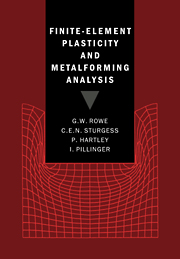Book contents
- Frontmatter
- Contents
- Preface
- Acknowledgements
- Nomenclature
- 1 General introduction to the finite-element method
- 2 Basic formulation for elastic deformation
- 3 Small-deformation elastic–plastic analysis
- 4 Finite-element plasticity on microcomputers
- 5 Finite-strain formulation for metalforming analysis
- 6 Implementation of the finite-strain formulation
- 7 Practical applications
- 8 Future developments
- Appendix 1 Derivation of small-strain [B] matrix for 2-D triangular element
- Appendix 2 Derivation of elastic [D] matrix
- Appendix 3 Derivation of elastic–plastic [D] matrix
- Appendix 4 Derivation of small-strain stiffness matrix [K] for plane-stress triangular element
- Appendix 5 Solution of stiffness equations by Gaussian elimination and back-substitution
- Appendix 6 Imposition of boundary conditions
- Appendix 7 Relationship between elastic moduli E, G and κ
- Appendix 8 Vectors and tensors
- Appendix 9 Stress in a deforming body
- Appendix 10 Stress rates
- Appendix 11 Listing of BASIC program for small-deformation elastic–plastic FE analysis
- Bibliography
- Index
6 - Implementation of the finite-strain formulation
Published online by Cambridge University Press: 22 September 2009
- Frontmatter
- Contents
- Preface
- Acknowledgements
- Nomenclature
- 1 General introduction to the finite-element method
- 2 Basic formulation for elastic deformation
- 3 Small-deformation elastic–plastic analysis
- 4 Finite-element plasticity on microcomputers
- 5 Finite-strain formulation for metalforming analysis
- 6 Implementation of the finite-strain formulation
- 7 Practical applications
- 8 Future developments
- Appendix 1 Derivation of small-strain [B] matrix for 2-D triangular element
- Appendix 2 Derivation of elastic [D] matrix
- Appendix 3 Derivation of elastic–plastic [D] matrix
- Appendix 4 Derivation of small-strain stiffness matrix [K] for plane-stress triangular element
- Appendix 5 Solution of stiffness equations by Gaussian elimination and back-substitution
- Appendix 6 Imposition of boundary conditions
- Appendix 7 Relationship between elastic moduli E, G and κ
- Appendix 8 Vectors and tensors
- Appendix 9 Stress in a deforming body
- Appendix 10 Stress rates
- Appendix 11 Listing of BASIC program for small-deformation elastic–plastic FE analysis
- Bibliography
- Index
Summary
INTRODUCTION
The previous chapter was concerned with producing a correct statement of the elastic–plastic element stiffness equations and their assembly into the global stiffness equations. As they stand, these expressions simply describe how the forces applied to the nodes of a discretised model of the workpiece change as those nodes are displaced by small amounts from their starting positions. It is now necessary to consider how these equations can be used within an FE analysis for the study of practical metalforming operations.
PERFORMING AN FE ANALYSIS – AN OVERVIEW
It is instructive to consider the entire process of performing an FE analysis of a metalforming operation (figure 6.1). Of the four main parts of this process, the FE calculation will always be undertaken by a computer program: the description of the metalforming operation and the pre-processing and post-processing stages may be integrated into the FE package, may be separate computer programs, or even be performed by hand.
The starting point in any such analysis is the metalforming operation itself. The first stage in the analysis is therefore concerned with obtaining a complete description of the operation in geometric or numerical form. This description will include information about the initial geometry of the workpiece, the shape of the dies and how the relative position and orientation of the dies and workpiece change during the deformation, the previous history of the workpiece and the dies, and the particular metal being formed.
Information
- Type
- Chapter
- Information
- Finite-Element Plasticity and Metalforming Analysis , pp. 80 - 115Publisher: Cambridge University PressPrint publication year: 1991
